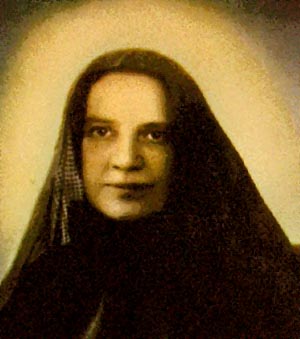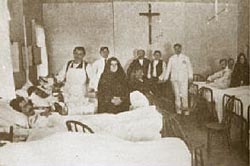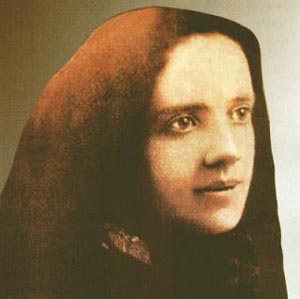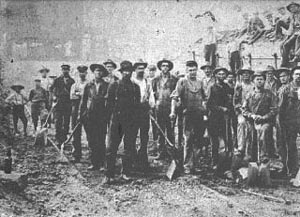 |
The Saint of the Day
St. Frances Xavier Cabrini - December 22
Prof. Plinio Corrêa de Oliveira
Biographical selection:
Maria Francesca Cabrini was born on July 15, 1850, the 13th child of pious peasants of Lombardy. She received her vocation on her Confirmation, as did St. Rose of Lima and other saints. She described the moment of her anointing: “I felt something beyond explanation. From that moment I was no longer of the earth. My heart was filled with the purest happiness. I knew that the Holy Ghost had come to me.”

St. Frances Cabrini, the first canonized U.S. citizen
|
At age 18 she was certified as a teacher under the Daughters of the Sacred Heart. She tried to enter several religious congregations, but her poor health stood in her way. Her most ardent desire was to do missionary work.
In 1871 her parish priest asked her to teach in the public school of a nearby village. Three years later diocesan authorities asked Frances to take over the direction of a poorly managed girls' orphanage in Codogno and to organize it with the structure and spirit of a religious institute. Soon she had a group of five helpers who, with her, pronounced religious vows in 1877. It was at that time Frances added Xavier to her name to honor the great missionary Francis Xavier.
The Bishop of Losi, however, opposed the house becoming an official religious community and commanded Frances, under threat of excommunication, to dissolve her small community. During this period of trial, she offered her sufferings with the aim of making reparation to Our Lord in His Agony of the Garden for both the sleep of His disciples and also the infidelities of her superiors until the end of the world.
When the first house was dissolved, the Bishop told her: “I know that you want to be a missionary, but I don’t see any religious congregation suited to you. Found one.” The saint reflected a moment, and responded, “I will found a religious congregation that fits me.” The Institute of Missionaries of the Sacred Heart of Jesus was founded as a diocesan congregation in 1881, with a simple Rule written by Mother Cabrini.

Mother Cabrini with the sick at hospital she founded in Columbus, Chicago, 1872
|
She set out for Rome, with aims of receiving pontifical approval for a universal missionary Institute with a central house in Rome. On March 12, 1888, Leo XIII granted an audience to the young foundress of the Missionaries of the Sacred Heart, approved her institute, and pointed to North America as her field of activity. There she could assist millions of Italian immigrants, many of whom - far from their homeland and religion – had drifted from the practice of their faith, lost in the cement desert of the great cities.
Thirty times she crossed the ocean, recruiting thousands of sisters for the 67 hospitals, schools and orphanages she established in the New World. “Let us work, let us work,” she used to say. “We will have an eternity to rest. Do what you can with an upright heart, and the Lord will do the rest.” The motto of St. Cabrini was “To love or to die.”
On December 22, 1917, she died of malaria in her own Columbus Hospital in Chicago
Comments of Prof. Plinio:
This selection suggests many ideas. The most important regards the sadness of Our Lord in the Garden of Olives and Mother Cabrini’s desire to make reparation for this until the end of the world.

From her youth, Frances had the desire to make reparation
|
In human affairs, a man can have a large debt with no means to pay it. If he has a wealthy friend, however, this friend can pay the debt for him. Doing this, he frees him from the penalty he would otherwise have had to pay for his insolvency. This - which is very easy to understand in earthly relations – has a much higher significance when applied to supernatural relations, our relations with God.
We have debts toward God Our Lord; we committed sins that removed us from the grace of God. For this reason, we need someone to pay that debt for us because we cannot pay it ourselves. How could a sinner pay, since he is in the state of sin? He is not pleasing to God. Nothing he does can be accepted by God. Therefore, it is necessary for another person to pay for the guilty one. An innocent person must take on himself a suffering correspondent to the illicit pleasure the sinner enjoyed.
For example, imagine that a lazy man misses a Sunday Mass because he wants to enjoy his rest. Someone has to pay for that illicit pleasure. An innocent person must make restitution for that sin with a proportionate amount of suffering. This basically explains reparation.
At times, God punishes the actual sinner so that the reparation is made by means of his chastisement. God allows evil things to happen to the sinner so
he can make restitution for that illicit pleasure he took. At other times God accepts the offering of another person, an innocent person who suffers for the sinner. Indeed, sometimes the sin was so great that a single person cannot pay for it. Yet other times, God awaits the reparation to let an innocent person show his love for Him.
For these various reasons, God calls souls to expiate sins, to make reparation for them.

She brought many Italian immigrant miners in Colorado back to the practice of the faith
|
What does reparation mean? When a piece of cloth is torn, to repair it means to sew it back together. The seamstress makes a new seam to repair the torn fibers of cloth. Analogously, to make reparation for the sins of another is to restore that person to the position he had before God. This is achieved by means of suffering, which attracts the mercy of God who again turns His eyes toward that person. The sinner receives new graces, converts and can fulfill the vocation he had received before he sinned.
Our Lord Jesus Christ offered His sufferings on the Cross as expiation for our sins. It was the only complete, total and true reparation. But He desires that men also suffer for one another to imitate Him and to somehow complete His infinitely precious Redemption. He knocks on the door of the soul and asks: “My child, won’t you accept this sacrifice to pay for your sins? Will you accept this other suffering for the Catholic Church? Will you take on this burden for the good of that soul? Give the alms of this sacrifice, I beg you.”
If we want to convert persons, if we want to correct our defects, we must suffer for them. This is reparation. Our Lady - who had seven swords of sorrow buried in her Heart - was the model of one who made reparation for us all.
This need for reparation was what moved St. Frances Cabrini. She chose to make expiation for the guilt of the Apostles in the Garden of Olives. We know that the Apostles, the first Bishops, slept at the moment when Our Lord was perspiring blood. So, she made reparation for that shameful behavior. She also saw members of the Hierarchy of her time doing wrong things and omitting other good things that should have been done. For the laziness, infidelity and egotism of the leaders of the Church of her time, she made reparation.

Working among Italian immigrants in the US cities
|
This selection recounts the enormous effort she made in the United States, the thousands of souls she recruited through the devotion of the Sacred Heart of Jesus, and how they persevered in the faith. All this Mother Cabrini offered with that same intention of reparation she had made in the beginning.
Who knows whether her expiatory sacrifices contributed to St. Pius X becoming Pope? That great Pope inflicted a huge defeat to Modernism, and to this date Progressivism, the heir of Modernism, has not been able to completely recover from it.
Mother Cabrini’s primary apostolate was to preserve the Italian immigrants from the American influence. The Italian immigrants to North America were in a different situation from those who came to South America - principally to Brazil and Argentina, where most of them arrived. In the Catholic countries, they encountered a Latin mentality. They integrated and fit into this mentality without any problem.
Those millions of Italians who disembarked in New York, however, encountered a Protestant and already highly industrialized country. They faced a very different productive mentality where everything was made at high speed to increase the profit margin. It was the opposite of the Latin spirit they were accustomed to in Italy. It was also completely different from the contemplative model of a soul turned toward reparation. Mother Cabrini went there to keep them from being assimilated into that mercantilist, revolutionary spirit. What an extraordinary example for us.
Let us ask St. Frances Cabrini to give us her spirit of reparation so that the many miseries inside the Church can be resolved. Let us also ask Our Lady to take our miserable sacrifices and purify, elevate and sanctify them, and then present them before God Our Lord.


  | | Prof. Plinio Corrêa de Oliveira | |
The Saint of the Day features highlights from the lives of saints based on comments made by the late Prof. Plinio Corrêa de Oliveira. Following the example of St. John Bosco who used to make similar talks for the boys of his College, each evening it was Prof. Plinio’s custom to make a short commentary on the lives of the next day’s saint in a meeting for youth in order to encourage them in the practice of virtue and love for the Catholic Church. TIA thought that its readers could profit from these valuable
commentaries.
The texts of both the biographical data and the comments come from personal notes taken by Atila S. Guimarães from 1964 to 1995. Given the fact that the source is a personal notebook, it is possible that at times the biographic notes transcribed here will not rigorously follow the original text read by Prof. Plinio. The commentaries have also been adapted and translated for TIA’s site.
|
Saint of the Day | Home | Books | CDs | Search | Contact Us | Donate

© 2002- Tradition in Action, Inc. All Rights Reserved
|
 |

|